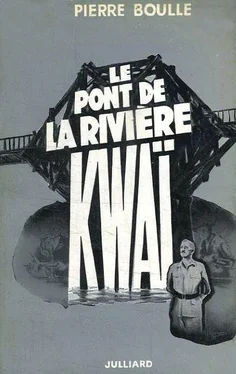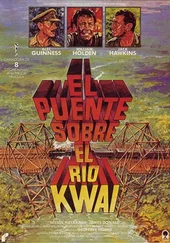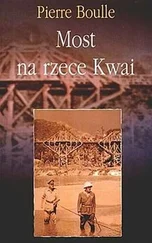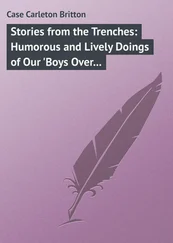“The Japanese soldiers’ quota will be two cubic yards,” Saito burst out. “I’ve already given the orders!”
Colonel Nicholson bowed in assent.
“In that case I expect we’ll make good progress. I don’t think there’s anything more to be said, Colonel Saito. It remains for me to thank you for your kind attention. If there are no other questions, gentlemen, I think we can declare this meeting closed. We’ll start work tomorrow on the conditions to which we have agreed.”
He got up, saluted, and withdrew, confident in the knowledge that he had conducted the meeting along the lines he wanted, that common sense had won the day, and that a decisive step had been taken toward completing the bridge. He had proved himself a skillful tactician, and he knew that he had deployed his forces in the best possible manner.
Clipton left with him, and together they walked back to their hut.
“What fools they are, sir!” said the M.O., looking closely at the Colonel. “To think that, without us, they would have built their bridge in a swamp and it would have capsized under the weight of their trains loaded with troops and supplies!”
There was a strange glint in his eye as he spoke, but the Colonel’s face remained inscrutable. This Sphinx-like character could not reveal his secret, since he had no secret to reveal.
“Yes, aren’t they?” he solemnly replied. “They’re what I’ve always said they were: primitive people, as undeveloped as children, who’ve acquired a veneer of civilization too soon. Underneath it all they’re absolutely ignorant. They can’t do a thing by themselves. Without us, they’d still be living in the age of sailing ships and wouldn’t own a single airplane. Just children … yet so pretentious as well! Think of it, a work of this importance! As far as I can make out, they’re only just capable of making a footbridge out of jungle creepers.”
There is nothing in common between a bridge, as conceived by civilized society in the West, and the utilitarian scaffoldings which the Japanese forces were in the habit of erecting in the continent of Asia. There is likewise no similarity between the two respective methods of construction. Qualified technicians did exist in the Japanese Empire, but they had been kept behind in the capital. In the occupied territories construction work was the army’s responsibility. The handful of engineers who had been dispatched to Siam had little skill and even less authority, and for the most part were overruled by the professional soldiers.
The latter’s method—which was speedy and, up to a point, fairly efficient—had been dictated by necessity; for during their advance through the countries they had overrun, they had found every installation destroyed by the enemy in retreat. It consisted of driving two rows of piles into the river bed, then crowning these supports with a tangle of mixed timber hastily put together with no thought of plan or design and with a total disregard for the principle of static pressure, and finally adding extra bits of wood at any point which showed obvious signs of weakness.
On this uncouth superstructure, which sometimes reached an enormous height, thick beams were laid in two parallel rows; and on top of these, the only timber to be more or less properly shaped, went the rails themselves. The bridge was then considered finished. It fulfilled the need of the hour. There was no parapet, no footpath. The only way to walk across was to step from one beam to another, balancing above the chasm—a feat at which the Japanese were adept.
The first convoy would go jolting across at low speed. The engine sometimes came off the rails at the point where the bank met the bridge, but a gang of soldiers armed with crowbars usually managed to heave it upright again. The train would then move on. If the bridge was damaged at all, more bits of timber would be added to the structure. And the next convoy would cross in the same way. The scaffolding would last a few days, a few weeks, sometimes even a few months, after which a flood would sweep it away, or else a series of more than usually violent jolts would make it capsize. Then the Japanese would patiently start rebuilding it. The materials they used were provided by the inexhaustible jungle.
The methods of Western civilization, of course, are not so elementary. Captain Reeves represented an essential element of that civilization—the mechanical—and would never have dreamed of being guided by such primitive empiricism.
But when it comes to bridge building, Western mechanical procedure entails a lot of grueling preliminaries, which swell and multiply the number of operations leading up to the actual construction. They entail, for instance, a detailed plan; and for this plan to be made it is essential to determine in advance the section and shape of every beam, the depth to which the piles are to be driven, and a mass of other details. Now each section, each shape, and the depth entail further calculations, based on figures representing the resistance of the various materials to be used and the consistency of the ground. These figures, in their turn, depend on coefficients worked out according to “standard patterns,” which in the civilized world are given in the form of mathematical tables. Mechanics, in fact, entail a complete a priori knowledge; and this mental creation, which precedes the material creation, is not the least important of the many achievements of Western genius.
There were no tables available on the banks of the Kwai, but Captain Reeves was an expert engineer and his theoretical knowledge enabled him to do without them, but only by increasing the number of preliminary duties and by experimenting with various weights and simple shapes before getting down to his calculations. He was thus enabled to-determine his coefficients by an easy method, using instruments hastily produced for the purpose, since there was not much time to spare.
With the approval of Colonel Nicholson, under the anxious eye of Saito and Clipton’s sardonic gaze, he set to work on these tests. At the same time he traced the best possible course for the railway to take, and passed the result to Major Hughes for action. With this off his chest, and with all the necessary data for his calculations ready, he embarked on the most interesting part of the work: the design and planning of the bridge.
He devoted himself to this task with the same professional conscientiousness that he had once shown when engaged on similar work for the Indian Government, and also with a passionate enthusiasm which he had hitherto tried to acquire, in vain, through reading suitable books (such as The Bridge Builders ), but by which he was now suddenly carried away as a result of a casual remark passed by the C.O.
“You know, Reeves, I’m relying on you entirely. You’re the only qualified man we have and I’m leaving everything in your hands. We’ve got to show we’re superior to these savages. I realize how difficult it is in this God-forsaken place where you can’t find what you need, but that makes the task all the more worthwhile.”
“You can count on me, sir,” Reeves had replied, feeling suddenly galvanized. “I won’t let you down, and we’ll show them what we’re capable of doing.”
This was the chance he had been waiting for all his life. He had always dreamed of tackling a really big job without being badgered every other minute by administrative departments or maddened by interfering officials who ask ridiculous questions and try to put a spoke in the wheels on the pretext of economy, thereby frustrating every creative effort. Here he was responsible to the Colonel and to no one else. The C.O. was favorably impressed; although he was a stickler for routine and “proper channels,” he could at least see the other man’s point of view and refused to be blinded by convention and protocol as far as the bridge was concerned. Besides, he had openly admitted he knew nothing about engineering, and made it quite clear he intended giving the junior officer his head. Certainly, the job was a difficult one, and there was a shortage of proper material, but Reeves promised to make up for every deficiency by his devotion to duty. He could already feel the breeze of creative inspiration fanning those hungry flames which overcome every obstacle in their path.
Читать дальше











